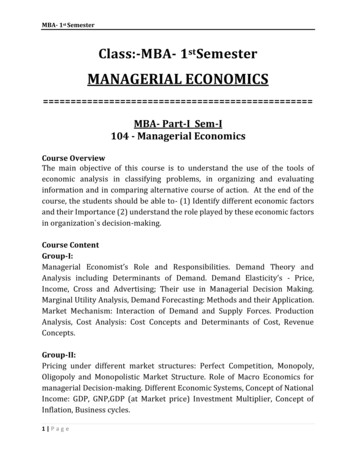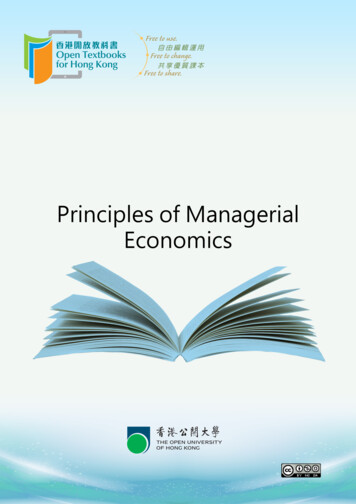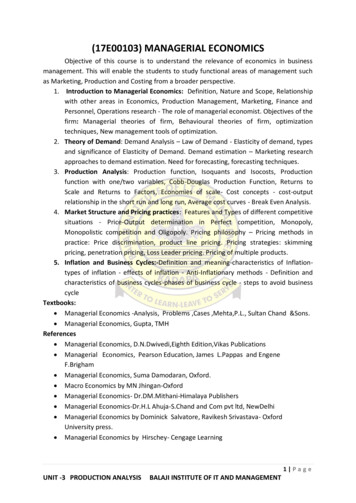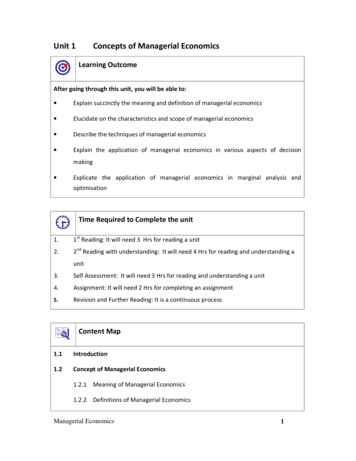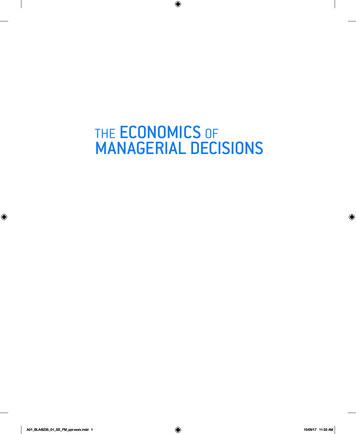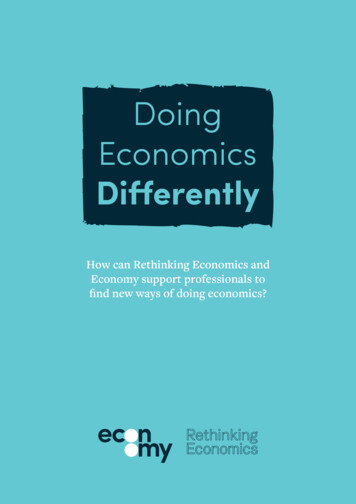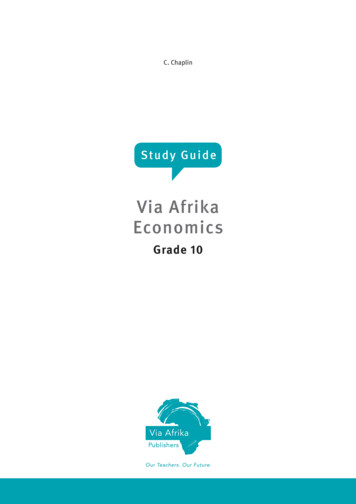
Transcription
LECTURE NOTESONMANAGERIAL ECONOMICS ANDFINANCIAL ANALYSISIII B.Tech II semesterM RAMESHAssistant ProfessorDepartment of MBA.COMPUTER SCIENCE AND ENGINEERINGINSTITUTE OF AERONAUTICAL ENGINEERING(Autonomous)DUNDIGAL, HYDERABAD - 5000431
UNIT-IINTRODUCTION TO MANAGERIAL ECONOMICS & DEMANDANALYSISECONOMICSEconomics is a study of human activity both at individual and national level. The economists ofearly age treated economics merely as the science of wealth. The reason for this is clear. Everyone of us involved in efforts aimed at earning money and spending this money to satisfy ourwants such as food, Clothing, shelter, and others. Such activities of earning and spending moneyare called “Economic activities”.According to Adam Smith“Economics as the study of nature and uses of national wealth”.According to Dr. Alfred Marshall“Economics is a study of man‟s actions in the ordinary business of life: it enquires how he getshis income and how he uses it”.MICRO AND MACRO ECONOMICSMicro EconomicsThe study of an individual consumer or a firm is called Micro Economics. It is also called thetheory of Firm.Micro means one millionth. Micro Economics deals with behaviour and problems of singleindividual and of micro organisation.Managerial EconomicsManagerial Economics has its roots in micro economics and it deals with the micro or individualenterprises.It is concerned with the application of concepts such as Price Theory, Law of Demand andTheories of market structure and so on.Macro EconomicsThe study of aggregate or total level of economic activity in a country is called MacroEconomics.2
It studies the flow of economic resources or factors of production (such as land, labour, capital,organisation and technology) from the resource owner to the business firms and then from thebusiness firms to the households.It deals with the total aggregates. For instance, total national income, total employment, totaloutput and total investment. It studies the interrelations among various aggregates and examinestheir nature and behaviour, their determination and causes of their fluctuations in them. It dealswith the price level in general, instead of studying the prices of individual commodities. It isconcerned with the level of employment in the economy. It discusses aggregate consumption,aggregate investment, price level and national income. The important tools of macro economicsinclude national income analysis, balance of payments and theories of employment and so on.INTRODUCTION TO MANAGERIAL ECONOMICSManagerial Economics as a subject gained popularity in USA after the publication of book“Managerial Economics” by Joel Dean in 1951.Managerial Economics refers to the firm‟s decision making process. It could be also interpretedas “Economics of Management”.Managerial Economics is also called as “Industrial Economics” or “Business Economics”.Joel Dean observes managerial economics shows how economic analysis can be used informulating policies.DEFINITIONS OF MANAGERIAL ECONOMICS1.M.H.SPENCER AND L. SIEGELMANManagerial Economics defined as “the integration of economic theory with businesspractice for the purpose of facilitating decision making and forward planning bymanagement”.2. BRIGHAM AND PAPPASbelieve that managerial economics is “The application of economic theory andmethodology to business administration practice”.3.C.I.SAVAGE AND T.R.SMALLtherefore believes that managerial economics is concerned with business efficiency.4.HAGUE observes that“Managerial Economics is a fundamental academic subject which seeks to understand andto analyse the problems of business decision-making”.5.In the words of PAPPAS AND HIRSHEY“Managerial Economics applies economic theory and methods to business andadministrative decision-making. Because it uses the tools and techniques of economicanalysis to solve managerial problems, managerial economics links traditionaleconomics with decision sciences to develop important tools for managerial decisionmaking”.6.MICHAEL R.BAYE definesManagerial Economics as “the study of how to direct scarce resources in a way that mostefficiently achieves a managerial goal”.3
7.HAYNES, MOTE AND PAUL defineManagerial Economics as “economics applied in decision-making. They consider this asa bridge between the abstract theory and the managerial practice”.Managerial Economics, therefore, focuses on those tools and techniques, which are usefulin decision-making.MANAGERIAL ECONOMICS:Managerial Economics refers to the firm‟s decision making process. It could be also interpretedas “Economics of Management”. Managerial Economics is also called as “IndustrialEconomics” or “Business Economics”.Managerial Economics bridges the gap between traditional economics theory and real businesspractices in two days. First it provides a number of tools and techniques to enable the manager tobecome more competent to take decisions in real and practical situations. Secondly it serves asan integrating course to show the interaction between various areas in which the firm operates.NATURE / CHARACTERISTICS OF MANAGERIAL ECONOMICS(a) Close to microeconomics: Managerial economics is concerned with finding the solutions fordifferent managerial problems of a particular firm. Thus, it is more close to microeconomics.(b) Operates against the backdrop of macroeconomics: Themacroeconomics conditions of the economy are also seen as limiting factors for the firm tooperate. In other words, the managerial economist has to be aware of the limits set by themacroeconomics conditions such as government industrial policy, inflation and so on.(c) Normative statements: A normative statement usually includes or implies the words „ought‟ or„should‟. They reflect people‟s moral attitudes and are expressions of what a team of peopleought to do. For instance, it deals with statements such as„Government of India should open up the economy. Such statement are based on valuejudgments and express views of what is „good‟ or „bad‟, „right‟ or „ wrong‟. One problem withnormative statements is that they cannot to verify by looking at the facts, because they mostlydeal with the future. Disagreements about such statements are usually settled by voting on them.(d) Prescriptive actions: Prescriptive action is goal oriented. Given a problem and the objectives ofthe firm, it suggests the course of action from the available alternatives for optimal solution. Ifdoes not merely mention the concept, it also explains whether the concept can be applied in agiven context on not. For instance, the fact that variable costs are marginal costs can be used tojudge the feasibility of an export order.(e) Applied in nature: „Models‟ are built to reflect the real life complex business situations andthese models are of immense help to managers for decision-making. The different areas wheremodels are extensively used include inventory control, optimization, project management etc. Inmanagerial economics, we also employ case study methods to conceptualize the problem, identifythat alternative and determine the best course of action.4
(f)Offers scope to evaluate each alternative:Managerial economics provides an opportunity to evaluate each alternative in terms ofitscosts and revenue. The managerial economist can decide which is the better alternative tomaximize the profits for the firm.(g) Interdisciplinary: The contents, tools and techniques of managerial economics are drawn fromdifferent subjects such as economics, management, mathematics, statistics, accountancy,psychology, organizational behaviour, sociology and etc.(h) Assumptions and limitations: Every concept and theory of managerial economics is based oncertain assumption and as such their validity is not universal. Where there is change inassumptions, the theory may not hold good at all.SCOPE OF MANAGERIAL ECONOMICSThe main focus in managerial economics is to find an optimal solution to a given managerialproblem, the problem may related to production, reduction or control of cost, determination ofprice of a given product or service, make or decisions, inventory decisions, capital managementor profit planning and management, investment decisions or human resource management.While all these are the problems, the managerial economics makes use of the concepts, tools andtechniques of economics and other related discipline to find an optimal solution to a givenmanagerial problem.The main Areas of Managerial Economics1.Demand Decision: The analysis and forecasting of demand for a given product and service is the first task ofthe managerial economist. The behavioural implications such as the needs of the customers responses to a given changein the price or supply are analysed in a scientific manner. The impact of changes in prices, income levels and prices of alternative products / servicesare assessed and accordingly the decisions are taken to maximise the profits. Demand at different price levels at different points of time ias forecast to plan the supplyaccordingly and initiate changes in price, if necessary, to enlarge the customer base and gainmore profits. Determination elasticity of demand and demand forecasting constitute the strategic issuesthat the managerial economist handles in a scientific way.2.Input-Output Decision:oHere, the costs of inputs in relation to output are studied to optimise the profits.oProduction function and cost function are estimated given certain parameters.oThe behaviour of costs at different levels of production is assessed here.some costs are fixed,some are semi-variable and others are perfectly variable.oThe quantity of production increases remains constant or decreases with additional increasein outputs.oThis decision deals with changes in the production following changes in inputs which couldbe substitutes or complementary.oThe entire focus of this decision is to optimise(maximise) the output at minimum cost.5
o2.If it is necessary for the manager to know the relationship between the cost and output bothin the short-run and long-run to position his products amidst the competitive environment.Price-Output Decision:Here, the production is ready and the task is to determine the price these in different marketsituations such as perfect market and imperfect markets ranging from monopoly,monopolistic competition, duopoly and oligopoly.The features of these markets and how price is determined in each of these competitivesituations is studied here.The pricing policies, methods, strategies and practices constitute crucial part of the study ofmanagerial economics.Profit -related Decisions:oHere we employ the techniques such as Break even analysis, cost reduction and cost controland ratio analysis to ascertain the level of profits.oWe determine break-even point beyond which firm start getting profits.oIn other words, if the firm produces less than break- even point, it loses.oWe can also plan the production needed to attain a given level of profits in short-run.oCost reduction and cost control deal with the strategies to reduce the wastage and therebyreduce the costs.oThese indirectly enhance the level of profits.o Ratio analysis helps to determine the liquidity, solvency, profitability of the activities of thefirm.oThere are certain ratios used to analyse and interpret the profitability of the firm given a setof accounting data.4. Investment Decisions Investment decisions are also called capital budgeting decisions. These involve commitment of large funds, which determine the fate of the firm. These decisions are irreversible. Hence the manager needs to be more attentive while committing his scarce funds, whichhave alternative uses. The allocation and utilisation of investments is paramount importance. Capital has a cost. It is expensive. Hence, it is to be utilised in such a way as to maximisethe return on capital invested. It is necessary to study the cost of capital structure and investment projects before the fundsare committed.6.Economic Forecasting and Forward Planning Economic forecasting leads to forward planning. The firm operates in an environment which is dominated by the external and internal factors. The external factors include major forces such as government policy, competition,employment, labour, price and income levels and so on. These influence its decision relating to production, human resources, finance and marketing. The internal factors include its policies and procedures relating to finance, people, marketand products. It is necessary to forecast the trends in the economy to plan for the future in terms ofinvestments, profits, products and markets. This will minimise the risk and uncertainty aboutthe future.6
DEMAND ANALYSISDemandDemand in common parlance means the desire for an object. But in economics demand is somethingmore than this. According to Stonier and Hague, “Demand in economics means demand backed up byenough money to pay for the goods demanded”. This means that the demand becomes effective only it ifis backed by the purchasing power in addition to this there must be willingness to buy a commodity.Every want supported by the willingness and ability to but constitutes demand for a particular product orservices. In other words, if I want a car and I cannot pay for it, there is no demand for the cat from myside.A product or services is said to have demand when three conditions are satisfied:Desire on the part of the buyer to buyWillingness to pay for itAbility to pay the specified price for it.DETERMINANTS OF DEMANDThere are so many factors on which the demand for a commodity depends. These factors areEconomic, Social as well as Political factors.The affect of all these factors on the amount of demanded for the commodity is called DemandFunction.The following are some of the factors that cause a change in demand other than price factor.1. PRICE OF THE COMMODITY:The most important factor affecting on demand is the price of the commodity.The amount of the commodity demanded at a particular price is more popularly called pricedemand. The relation between price and demand is called the Law of Demand.It is not only the existing price but also expected changes in price, which affect demand.2. PRICES OF RELATED GOODS3.i)CHANGE IN THE PRICES OF SUBSTITUTES:In case of substitutes like tea and coffee an increase in price of one commodity leads toan increase in the demand for other commodity and vice versa.The rise in price of coffee shall raise the demand for tea.ii)CHANGE IN THE PRICES OF COMPLEMENTARIES: In case of complementariness like car and petrol a fall in price of one commodity leads toan increase in the demand for other commodity and vice versa. If the price of pens goes up, their demand is less as a result of which the demand for inkis also less. The price and demand go in opposite direction. The effect of changes in pricea commodity on amounts demanded of related commodities is called cross demand.INCOME OF THE CONSUMERThe third most important factor influencing demand is consumer income.In fact we can establish a relationship between the consumer income and demand atdifferent levels of income, price and other things remaining same.7
The demand for a normal commodity goes up and falls down when income rises and fallsdown.But in case of Giffen goods the relationship is opposite.Demand always changes with a change in the incomes of the people.When income increases the demand for several commodities increases and vice versa.4.TASTES AND FASHIONS OF CONSUMERSThe fourth most important factor influencing demand is consumers‟ tastes and fashions.The demand also depends on consumer's taste. Tastes include fashion, habit, customs etc.A customer taste is also affected by advertisement.If the taste for a commodity goes up, its amount demanded is more even at the same price.This is called increase in demand. The opposite is called decrease in demand.A change in the tastes and fashions brings about a change in demand for a commodity.When commodity goes out of fashion, the demand for it will decrease even though theprice remains the same. Demand curve shifts to the left.5.AFFECT OF WEALTHThe amount demanded of the commodity is also affected by the amount of wealth as wellas its distribution.When the wealth of the people is more, demand for the normal commodities is also more.If wealth is more equally distributed, the demand for necessaries and comforts is more.On the other hand, if some people are rich, while the majorities are poor, the demand forluxuries is generally higher.6.CHANGE IN POPULATIONIncrease in population increases demand for necessaries of life.The compositions of population also affect demand.Composition of population means the proportion of young and old and children as well asthe ratio of men and women.A change in composition of population has an affect on the nature of demand for differentcommodities.A change in size as well as composition of population will affect the demand for certaincommodities.For example: An increase in size of population will increase the demand for food grains.Similarly, an increase in percentage of women increases the demand for bangles and sarees.7.CHANGES IN CLIMATE AND WEATHERDemand always changes with a change in weather or climate even though price remainsunchanged.In summer the demand for cool drinks increases and in winter it decreases.The climate of an area and the weather prevailing there has a decisive effect onconsumer‟s demand.In cold areas woollen cloth is demanded. During hot summer days, ice is very much indemand. On a rainy day , ice cream is not so much demanded.8. CHANGES IN GOVERNMENT POLICYGovernment policy affects the demand for commodities through taxation.Taxing a commodity increases its price and demand goes down.Similarly, financial help from government increases the demand for a commodity whilelowering its price.8
9. EXPECTATIONS REGARDING THE FUTUREIf consumers expect changes in price of commodity in future, they will change the demand atpresent even when the present price remains the same.Similarly, if consumers expect their incomes to rise in the near future they may increase thedemand for a commodity just now.10. STATE OF BUSINESS:The level of demand for different commodities also depends upon the business conditions in thecountry.If the country is passing through boom conditions, there will be a marked increase in demand.On the other hand, the level of demand goes down during depression conditions.11. ADVERTISEMENT:Advertisement has become the most popular means in changing the demand for a commodity inthe modern world.By a regular advertisement the preference of the consumers can be influenced.12. TECHNICAL PROGRESSDue to technical progress new commodities will enter into the market and demand for the oldcommodities will decrease.For example, Due to the introduction of electronic watches the demand for ordinary watches hasdecreased.Demand functionDemand function is a mathematical expression of relation between the quantity demanded andits determinants. It can be expressed as followsQD F( P, I, Psc, T, A)WhereQd quantity demandF functional relational between inputP price of the productI income of the consumerPsc price of substituted or complementaryT taste and preferenceA advertisement9
DEMAND ANALYSISINTRODUCTION OF DEMAND:Demand in common practice / ordinary language means the desire for an object. Suppose aperson desires to have a car. It is called demand in ordinary usage.But in economics demand has a separate meaning which is quite distinct from the abovemeaning.A mere desire cannot become demand in Economics.A desire which is backed up by (i) ability to buy and (ii) willingness to pay the price, is calleddemand. Unless the desire is accompanied by ability to buy and willingness to pay, it cannot becalled demand in Economics.DEFINITIONS OF DEMAND1. According to Stonier and Hague,“ Demand in economics means demand backed up by enough money to pay for the goodsdemanded”.This means that the demand becomes effective only if it is backed by purchasing power inaddition to this there must be willingness to buy a commodity.Thus demand in economics means the desire backed by the willingness to buy a commodity andthe purchasing power to pay.2. In the words of Benham,“The demand for anything at a given price is the amount of it which will be bought per unitof time at that price ”. (Thus demand is always at a price for a definite quantity at a specifiedtime.)Thus demand has three essentials i.e., price, quantity and time. Without these threedemand has no significance in economics.DEFINITIONS OF LAW OF DEMAND1.2.ALFRED MARSHALL stated that Law of Demand as“a rise in the price of commodity or service is followed by a reduction in demand and fallin price is followed by an increase in demand, if the conditions of demand remainconstant.”Marshall stated that the Law of Demand basing on the law of Diminishing Marginal utilityIn the words of SAMUELSONthe Law of Demand may be stated as“Other things being equal, the quantity demanded increases with a fall in price anddecreases with a rise in price.”Law of DemandLaw of demand states the relationship between price and quantity demanded. As per the lawwhen price is increased demand will decrease, and similarly, when price is decrease demand willincrease, this law assumed that, other things remaining constant, the change in price will inversely affectdemand, thus the relationship between price and demand is inverse.A rise in the price of a commodity is followed by a fall in demand and a fall in price is followed by a risein demand, if a condition of demand remains constant.10
DEMAND SCHEDULEThe Law of Demand may be explained with the help of the following Demand Schedule.Price of MangoesQuantity Demanded( Rs.)12522031541055DEMAND CURVE5D43Price(Rs)21D5 10152025Quantity DemandedFrom the above table it is clear that as price of Mangoes rises from Rs.1 to Rs.2 demand fallsfrom 25 to 20.When the price of Mangoes rises to Rs.5 quantity demand falls to 5 Mangoes.In the same way as price rises , quantity demand falls on the basis of demand schedule.We can draw a demand curve from the above Demand Schedule as follows.11
In the above Diagram, demand is shown on OX –axis and price is shown on OY-axis.DD is the demand curve.The demand curve DD shows the inverse relation between price and quantity demand ofMangoes.The demand curve slopes downward from left to right.ASSUMPTIONS OF LAW OF DEMANDLaw of Demand is based on the following assumptions. The Law will hold good only if thefollowing assumptions are fulfilled.1. That the tastes and fashions of the people remain unchanged.2. That the people‟s income remains unchanged / constant.3. That the prices of related goods remain unchanged / same.4. That there are no substitutes for the commodity in the market.5. That the commodity is not the one which has prestige value such as diamonds etc.6. That the demand for the commodity should be continuous.7. That the people should not expect any change in the price of the commodity.EXCEPTIONS TO THE LAW OF DEMAND Some times in case of some commodities demand curve slopes upwards from left to right.It shows that when price rises demand also rises and when price falls demand also falls.In this case the demand curve has a positive slope.We can draw the Exceptional Demand Curve as follows.DPrice (Rs.)DQuantity Demanded12
In the above Diagram, demand is shown on OX –axis and price is shown on OY-axis.DD is the demand curve.When price increases from OP to OP1 quantity demand also increases from OQ to OQ1 andthe price falls down from OP1 to OP quantity demand also falls down from OQ1 to OQ.Hence the exceptional demand curve slopes upwards from left to right in this diagram.The following are the important exceptions to the Law of Demand.1. Giffen Paradox2. Prestige goods 3. Speculation4. Trade Cycles5. Changes in Expectations.1. GIFFEN PARADOX In the early part of the 19th Century, Sir Robbert Giffen, a British Economist observed thatthe Low paid British workers were purchasing more bread, when its price increased. This is some thing contrary to the law of demand. He observed that the people spend a major portion of their incomes on bread only a smallpart on meat. Meat is more costly but less essential that bread. When the price of the bread increased, they reduced the expenditure on meat. With the money thus saved they purchased more bread to compensate for the loss of meat. Thus where the price of bread is increases, its demand is also increased. This is the againstlaw of demand. This paradox was stated by Sir Robbert Giffen. Therefore, it is called Giffen Paradox. Marshall could not explain this. It appeared to be a paradox to him. The Demand Curve for Giffen goods(Inferior goods) goes upward from left to right asshown in the above diagram.2. PRESTIGE GOODS:This exception is explained by Veblen. Costly goods like Diamonds, cars etc., are calledprestige goods or as Veblen goods.Generally rich people purchase those goods for the sake of prestige.The use of such articles increases the prestige of owners.So rich people may buy more of such goods when their prices rise.Thus the amount demanded rises instead of falling; when the prices fall they do notpurchase them because their value is reduced.Therefore the demand decreases when the price falls.This is against to the Law of Demand.Since this exception is stated by Veblen, it is called Veblen effect.3. SPECULATION:When the price of a commodity rises and people expect that it will rise still further.Hence they buy more of that commodity.Similarly, if they expect that there is going to be a further fall in the price, demand may notexpand.This is contrary to the Law of Demand.4. TRADE CYCLES:During the periods of economic prosperity, people buy more even when the prices rise.This happens because the incomes of the people have gone up.During times of depression, people buy less and less even when prices fall.13
5. CHANGES IN EXPECTATIONS:When people expect a further rise in prices, people buy more when prices rise.They want avoid paying more in future.Similarly, when people expect the prices to fall in further, they buy less and less as prices fall.They may be expecting a further in prices.ELASTICITY OF DEMANDElasticity of demand explains the relationship between a change in price and consequent changein amount demanded. “Marshall” introduced the concept of elasticity of demand. Elasticity ofdemand shows the extent of change in quantity demanded to a change in price.In the words of “Marshall”, “The elasticity of demand in a market is great or small according asthe amount demanded increases much or little for a given fall in the price and diminishes muchor little for a given rise in Price”Elastic demand: A small change in price may lead to a great change in quantity demanded. Inthis case, demand is eastic.In-elastic demand: If a big change in price is followed by a small change in demanded then thedemand in “inelastic”.Types of Elasticity of Demand:There are three types of elasticity of demand:1.2.3.4.Price elasticity of demandIncome elasticity of demandCross elasticity of demandAdvertising elasticity of demandPrice elasticity of demand:Elasticity of demand in general refers to price elasticity of demand. In other words, it refers tothe quantity demanded of a commodity in response to a given change in price. Price elasticity isalways negative which indicates that the customer tends to buy more with every fall in the price,the relationship between the price and the demand is inverse.Proportionate change in the quantity demand of commodityPrice elasticity --------------Proportionate change in the price of commodityEdp Q2 - Q1/ Q1---------------P2 – P1 /P1Where:Q1 quantity demand price before changeQ2 quantity demand price after changeP1 price before changeP2 price after change14
Income elasticity of demand:Income elasticity of demand refers to the quantity demand of a commodity in response to agiven change in income of the consumer.Proportionate change in the quantity demand ofcommodityIncome Elasticity --------------Proportionate change in the income of the peopleEdI Q2 - Q1/ Q1---------------I2 – I1 /I1Where:Q1 quantity demand price before changeQ2 quantity demand price after changeI1 income before changeI2 income after changeCross elasticity of demand:Cross elasticity of demand refers to the quantity demanded of a commodity in responseto a change in the price of a related good, which may be substitute or complement.Cross elasticity Proportionate change in the quantity demand of commodity -------------------------------Proportionate change in the price of commodity “Y”EdP Q2 - Q1/ Q1---------------P2 – P1 /P1Where:Q1 quantity demand price before changeQ2 quantity demand price after changeP1 price before changeP2 price after changeAdvertising elasticity of demand:It refers to increase in the sales revenue because of change in the advertising expenditure. Inother words, there is a direct relationship between the amount of money spent on advertising andits impact on sales. Advertising elasticity is always positive.15
Proportionate change in the quantity demand of product “X”Advertising elasticity -----Proportionate change in advertisement costs.EdP Q2 - Q1/ Q1---------------A2 – A1 /A1Where:Q1 quantity demand price before changeQ2 quantity demand price after changeA1 advertising before changeA2 advertising after changeMeasurement Elasticity of Demand1.2.3.4.5.Perfectly elasticity of demandPerfectly inelasticity of demandRelatively elasticity of demandRelatively inelasticity of demandUnity elasticity of demandPerfectly elasticity of demand:When any quantity can be sold at a given pric
Managerial Economics refers to the firm‟s decision making process. It could be also interpreted as “Economics of Management”. Managerial Economics is also called as “Industrial Economics” or “Business Economics”. Managerial Economics bridges the gap between traditional economics


